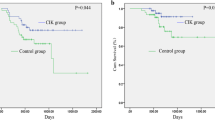Abstract
PURPOSE: Aim of this study has been to evaluate natural killer (NK) activity in patients with colorectal tumors before and after curative surgery. METHODS: Forty colorectal cancer patients without distant metastases were stratified according to American Joint Committee on Cancer/International Union Against Cancer staging system into three categories: Stage I (n = 12), Stage II (n = 15), and Stage III (n = 13). All of them underwent curative resection, and there were no major postoperative complications. Venous blood samples were obtained preoperatively, at surgical wound closure, and on the 1st, 7th, and 21st postoperative days. Mononuclear cells were isolated over Ficoll-Hypaque™(Lymphoprep, Nycomed Pharma AS, Oslo, Norway) gradients, and NK activity was assayed by evaluation of cytotoxic response against K562 cells. Normal NK activity was achieved from 15 healthy donors. Percentage relative increments in relation to preoperative levels were calculated for every postoperative sample, andt-test was used for statistical evaluation. RESULTS: Before surgery, Stages II and III patients had lower levels of NK activity than healthy people(P< 0.05 andP< 0.001, respectively). NK activity always fell after surgery (Stage I: -18.48±11.42; Stage II: −16.93±13.57; Stage III: −35.29±12.03, at day 1 postsurgery) and appeared to rise slightly by the 21st postoperative day in Stage I patients (+4.87±12.41). Stage II, and especially Stage III, patients did show a significant recovery by the 21st postoperative day (+23.63±9.36 and +43.19±13.34, respectively). At this time, NK activity in these two groups was not significantly lower than in normal subjects(P> 0.05). CONCLUSION: NK activity is depressed in colorectal cancer patients in relation to progression of illness, even at locoregional stages. Curative resection of tumors at Stages II and III has promoted a recovery of NK activity in patients with uneventful postoperative courses.
Similar content being viewed by others
References
Rosenberg SA, Lotze MT, Muul LM,et al. Observations on the systemic administration of autologous lymphokine-activated killer cells and recombinant interleukin-2 to patients with metastatic cancer. N Engl J Med 1985;313:1485–92.
Mule JJ, Yang J, Shu S, Rosenberg SA. The anti-tumour efficacy of lymphokine-activated killer cells and recombinant interleukin 2in vivo: direct correlation between reduction of established metastases and cytolytic activity of lymphokine-activated killer cells. J Immunol 1986;136:3899–909.
Hawkins MJ, Atkins MB, Dutcher JP,et al. A phase II clinical trial of interleukin 2 and lymphokine-activated killer cells in advanced colorectal carcinoma. J Immunother 1994;15:74–8.
Steis RG, Urba WJ, Van der Molen LA,et al. Intraperitoneal lymphokine-activated killer cell and interleukin 2 therapy for malignancies limited to the peritoneal cavity. J Clin Oncol 1990;8:1618–29.
Parks KG, Heys SD, Murray JB,et al. Recombinant interleukin-2 treatment in patients with metastatic colorectal cancer: effect on natural cytotoxicity. Cancer Immunol Immunother 1992;35:53–8.
Riddle PR, Berenbaum MC. Postoperative depression of the lymphocyte response to phytohemagglutinin. Lancet 1967;1:746–8.
Berenbaum MC, Fluck PA, Hurst NP. Depression of lymphocyte responses after surgical trauma. Br J Exp Pathol 1973;54:597–607.
Cullen BF, Van Belle G. Lymphocyte transformation and changes in leukocyte count: effects of anesthesia and operation. Anesthesiology 1975;43:563–9.
Miller GC, Pritchard DJ, Ritts RE, Ivins JC, Pierre RV. Effect of surgery on the quantity of lymphocyte subpopulations. J Surg Res 1976;21:155–8.
Gzerlak I, Olszewski WL, Engeset A. Influence of operative trauma on circulating blood mononuclear cells: analysis using monoclonal antibodies. Eur Surg Res 1984;16:105–12.
Hansbrough JF, Bender EM, Zapata-Sirvent R, Anderson J. Altered helper and suppressor lymphocyte populations in surgical patients: a measure of postoperative immunosuppression. Am J Surg 1984;148:303–7.
Takii Y, Hashimoto S, Iiai T, Watanabe H, Hatakeyama K, Abo T. Increase in the proportion of granulated CD56+ T cells in patients with malignancy. Clin Exp Immunol 1994;97:522–7.
Sedman PC, Ramsden CW, Brennan TG, Giles GR, Guillou PJ. Effects of low dose perioperative interferon on the surgically induced suppression of antitumour immune responses. Br J Surg 1988;75:976–81.
Nichols PH, Ramsden CW, Ward U, Sedman PC, Primrose JN. Perioperative immunotherapy with recombinant interleukin 2 in patients undergoing surgery for colo-rectal cancer. Cancer Res 1992;52:5765–9.
Nichols PH, Ramsden CW, Ward U, Trejdosiewicz LK, Ambrose NS, Primrose JN. Perioperative modulation of cellular immunity in patients with colorectal cancer. Clin Exp Immunol 1993;94:4–10.
Boyum A. Isolation of mononuclear cells and granulocytes from human blood: isolation of mononuclear cells by one centrifugation, and of granulocytes by combining centrifugation and sedimentation at 1g. Scand J Clin Lab Invest Suppl 1968;21:77–89.
European CML Study Group on the Third European CML Workshop. Human histocompatibility testing by T-cell mediated lympholysis: a European standard CML technique. Tissue Antigens 1980;16:335–45.
Wiltrout RH, Herberman RB, Zhang SR,et al. Role of organ-associated NK cells in decreased formation of experimental metastases in lung and liver. J Immunol 1985;134:4267–75.
Blottiere HM, Douillard JY, Koprowski H, Steplewski Z. Humoral and cellular responses of colorectal cancer patients treated with monoclonal antibodies and interferon gamma. Cancer Immunol Immunother 1990;32:29–37.
Atzpodien J, Kirchner H, Korfer A,et al. Expansion of peripheral blood natural killer cells correlates with clinical outcome in cancer patients receiving recombinant subcutaneous interleukin-2 and interferon-alpha 2. Tumour Biol 1993;14:354–9.
Author information
Authors and Affiliations
Additional information
Supported by the Valencian Health Care Service.
Read at the meeting of The American Society of Colon and Rectal Surgeons, Montreal, Canada, May 7 to 12, 1995.
About this article
Cite this article
Espí, A., Arenas, J., García-Granero, E. et al. Relationship of curative surgery on natural killer cell activity in colorectal cancer. Dis Colon Rectum 39, 429–434 (1996). https://doi.org/10.1007/BF02054059
Issue Date:
DOI: https://doi.org/10.1007/BF02054059




